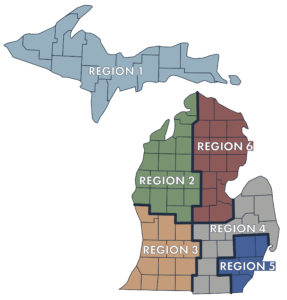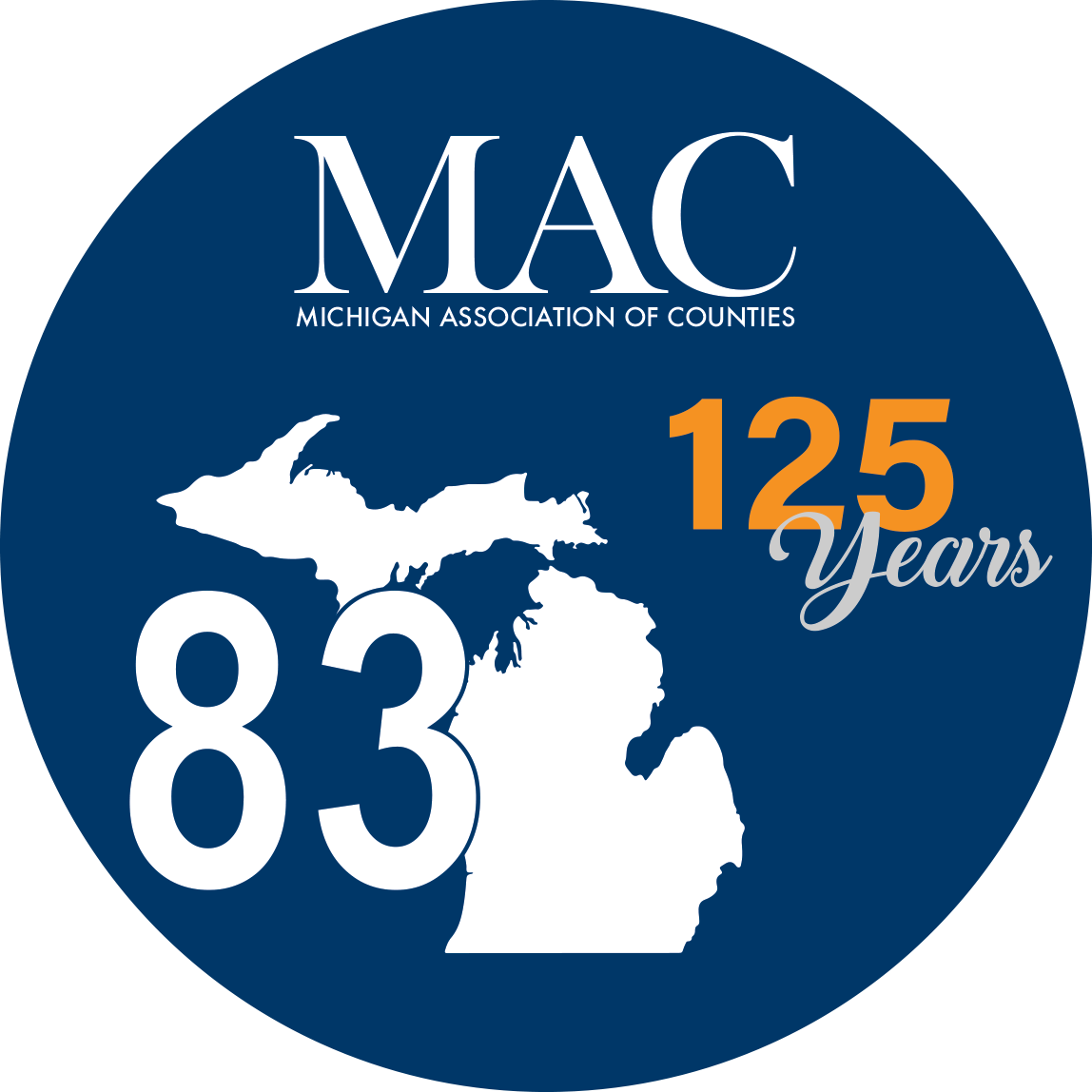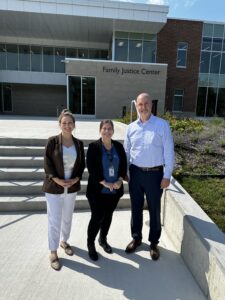Legislative Update 8-30-24
Candidates make their case for 2024 Board elections
 The field is set for this year’s elections for the MAC Board of Directors.
The field is set for this year’s elections for the MAC Board of Directors.
Six county commissioners have filed for the five available seats on the Board that will be filled via regional caucuses held on Sept. 25 at the 2024 Michigan Counties Annual Conference:
- Region I, Seat A
- Region II, Seat A
- Region III, Seat A
- Region V, Seat B
- At-large, Seat C
Only county commissioners registered for the Annual Conference may participate in the six regional caucuses. Only candidates who filed by the Aug. 23 deadline are eligible to be elected.
Regional seats are determined by the votes of that region’s caucus, with each county represented in the caucus room receiving one vote. The at-large seat is filled by the candidate receiving a majority of votes (with each commissioner casting a vote) in at least four of the six caucuses. (For questions on election procedures, contact Communications Director Derek Melot at melot@micounties.org.)
Candidates provided statements to MAC to share with colleagues:
- Click here for statement from John Malnar, Delta County, Region 1 candidate.
- Click here for statement from Craig Reiter, Schoolcraft County, Region 1 candidate.
- Click here for statement from Bryan Kolk, Newaygo County, Region 2 candidate.
- Click here for statement from Rick Shaffer, St. Joseph County, Region 3 candidate.
- Click here for statement from Sarah Lucido, Macomb County, Region 5 candidate.
- Click here for statement from Melissa Daub, Wayne County, At-large candidate.
Michigan FY 2025 County Revenue Sharing Projections Released
 The Michigan Department of Treasury has recently posted the Fiscal Year (FY) 2025 County Revenue Sharing projections, providing an essential preview of the expected funds that will be distributed to counties across the state. These projections offer a insight into how the new distribution model will affect each county.
The Michigan Department of Treasury has recently posted the Fiscal Year (FY) 2025 County Revenue Sharing projections, providing an essential preview of the expected funds that will be distributed to counties across the state. These projections offer a insight into how the new distribution model will affect each county.
The changes to the distribution methodology are the result of the changes made to the State’s FY 2025 enacted budget for Michigan. For years, county revenue sharing was based on an outdated model that was rooted in values from, among other things, a 1975 inventory tax, inflationary increases for those counties still drawing down from a reserve fund and random percentage increases and decreases decided on by the legislature and the administration. The old methodology also required counties to earn a portion of their revenue sharing with reports at the local level and state level.
The new methodology has it’s roots in previous distributions but the unprecedented $30M increase for county revenue sharing this year will be distributed based on a counties taxable value as compared with the rest of the State. All counties will see an increase in revenue sharing for FY 2025 compared to previous years. However, the actual impact on each county’s budget from the $30M increase will vary depending on the final 2024 taxable values.
The Michigan Department of Treasury projected revenue sharing payments for each county for FY 2025, FY-2025-County-Revenue-Sharing-Projections-8-29-24.pdf (michigan.gov), are based on the taxable values from 2023, which have been used as the foundation for estimating the amount each county will receive. However, it’s important to note that the actual payments to counties will be calculated based on the 2024 taxable values, which are expected to be released later in September. This means that the figures currently provided are preliminary and subject to change once the updated taxable values are available.
The Department of Treasury is expected to notify counties of the final revenue sharing amounts sometime next week, but they will only be projections until the 2024 taxable values are finalized.
In conclusion, the FY 2025 County Revenue Sharing projections provide a valuable early look at the funding counties can expect in the coming fiscal year. While the final amounts will depend on the forthcoming 2024 taxable values, these projections serve as an early indication on what counties can expect to receive. For more information, contact Deena Bosworth at bosworth@micounties.org
MAC on the Road: Ottawa County
MAC’s Samantha Gibson toured Ottawa County’s Family Justice Center, juvenile detention center and day treatment center for youth community-based programming. The newly unveiled Family Justice Center and the programming, resources and opportunities made available to youth in the juvenile detention center and day-treatment programs exemplify the positive result of strong partnerships between boards of commissioners and courts, ultimately benefiting the youth within their communities. Thank you to Thom Lattig, Ottawa County juvenile court director, and Kathie Kolean, assistant director of court operations, for providing the tour of their campus.
Podcast 83: Artificial Intelligence is the present, not the future, says NACo expert
 County leaders feeling hesitant about artificial intelligence (AI) entering their workplaces need to realize the technology is already there – and will be a boon to them and their staffs, said a National Association of Counties (NACo) expert in the newest episode of Podcast 83.
County leaders feeling hesitant about artificial intelligence (AI) entering their workplaces need to realize the technology is already there – and will be a boon to them and their staffs, said a National Association of Counties (NACo) expert in the newest episode of Podcast 83.
Rita Reynolds, NACo’s chief information officer, and host Stephan Currie conducted a wide-ranging discussion on AI terminology, its scope and how county leaders can use a new NACo toolkit to adapt to this seminal technology.
“When you start looking at some of those recommendations in generative AI, and were we first going to start seeing it in county government, where are we going to see it initially?” Currie asked. “Is it in the back office? Is it front office? … Talk a little bit about that, where you’re starting to see counties implement some generative AI.”
“Early on ― and even now ― there’s a definite focus with what we would call the productivity applications, which really, mostly, are the back office,” Reynolds replied. “So, for productivity, it’s those type of tasks where I’m doing the same thing over and over, and it’s taking me a lot of time, or it is so repetitive that’s why I can hand this off to someone.
“And it could be as simple as meeting notes, having the artificial intelligence work for you during a meeting and summarize the meeting minutes at the end of it, it could be taking a chunk of information, maybe you’ve written something for an article, but you’re not happy with the way it’s worded. Or you need to reword it in simpler terms. And so that’s generative AI, as we call it, the tool that allows you to put information in and it generates out a response that is potentially easier to understand or more professional.”
“What do you foresee the future now is of this toolkit?” Currie asked.
“We already do have a game plan and a roadmap. Basically, the toolkit is live on the naco.org website. … There’s also an interactive, tabular type page that allows you to say, ‘I’m an elected official, take me to those sections that I need to really be aware of.’ And it’ll take you to the benefits, the challenges, the opportunities, some use cases and then several, not all, of the work recommendations,” Reynolds explained.
“I would like to just mention,” Reynolds concluded, “from the challenge perspective, the (NACo) committee was very cognizant that there are areas such as accuracy, relevancy and, of course, particularly bias that could be in the data. And we’ve all said all along, there’s always been that type of problem. Generative AI just brings it to the forefront and actually gives counties now the opportunity to be better at cleaning up the data and making it relevant.”
View the full episode, recorded on Aug. 5, by clicking here.
Previous episodes can be seen at MAC’s YouTube Channel.
And you always can find details about Podcast 83 on the MAC website.
 Staff picks
Staff picks
- 10 ways that states can improve substance use treatment (Pew Trusts)
- America is at a crossroads with its infrastructure future (American City and County)
- Most Workers Make About the Same as Pre-Pandemic. But Not in These States. (Stateline)
- A child was reported missing. A TV news helicopter crew spotted him on the roof playing hooky (Associated Press)







